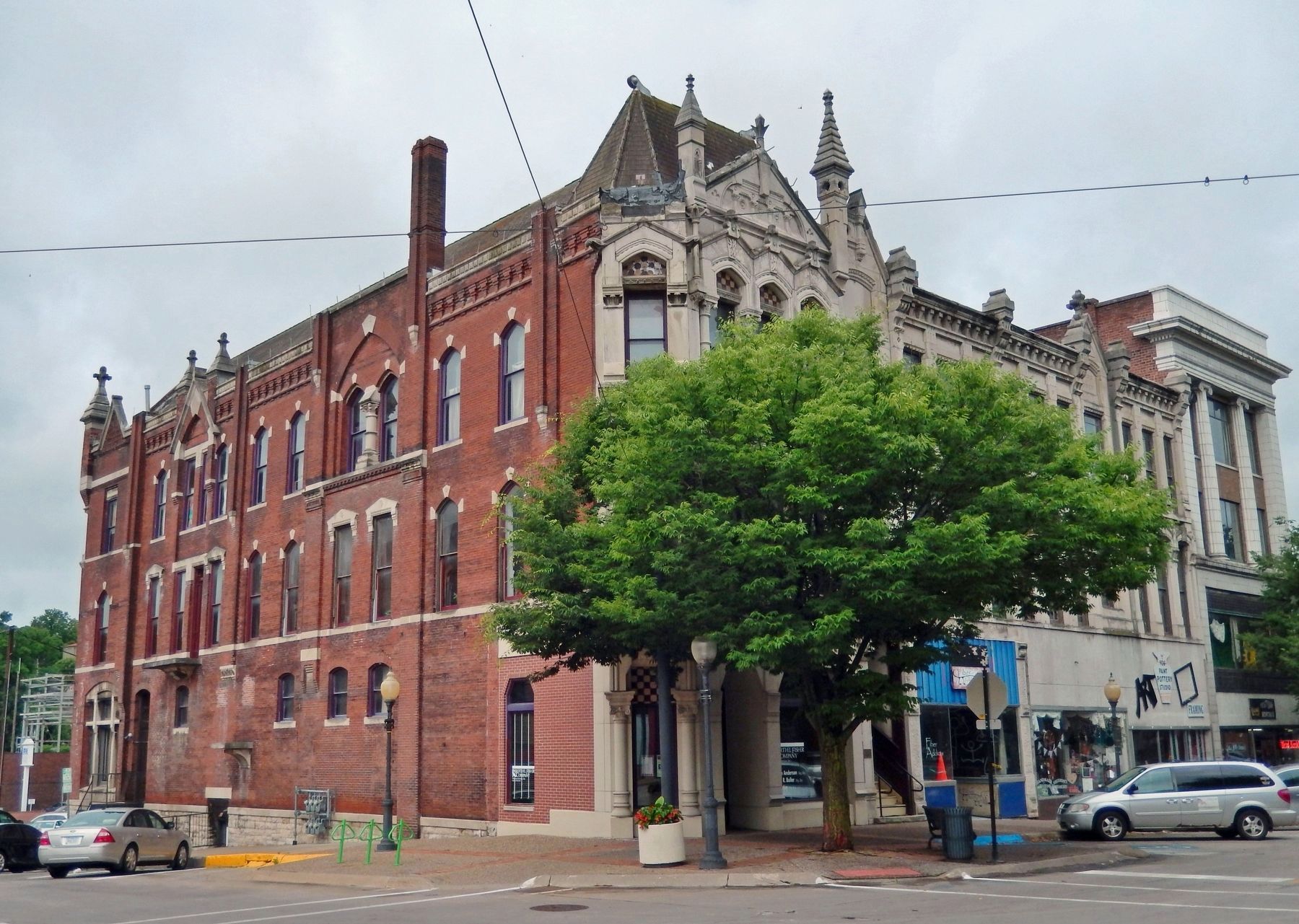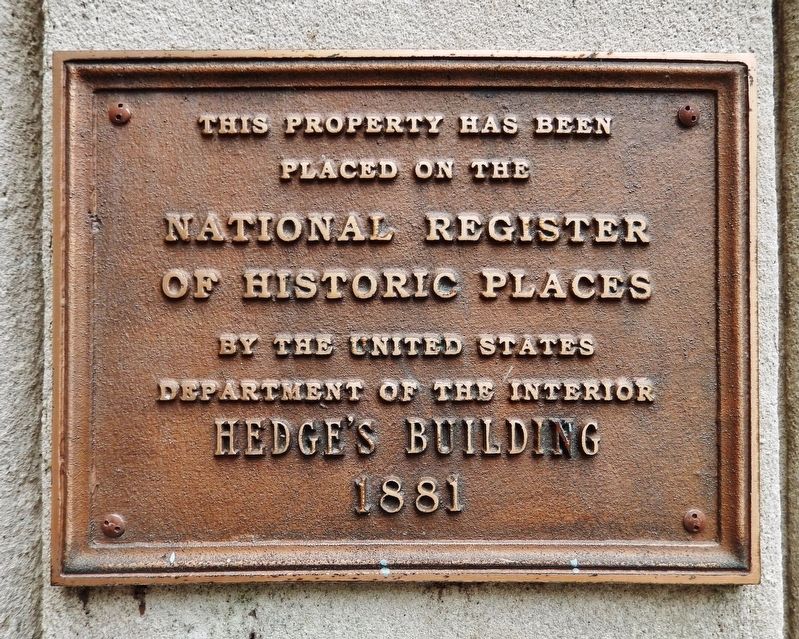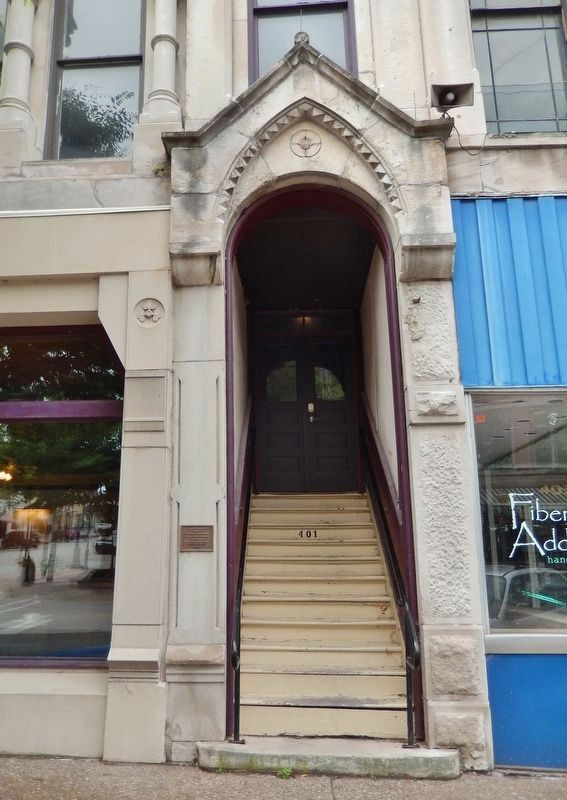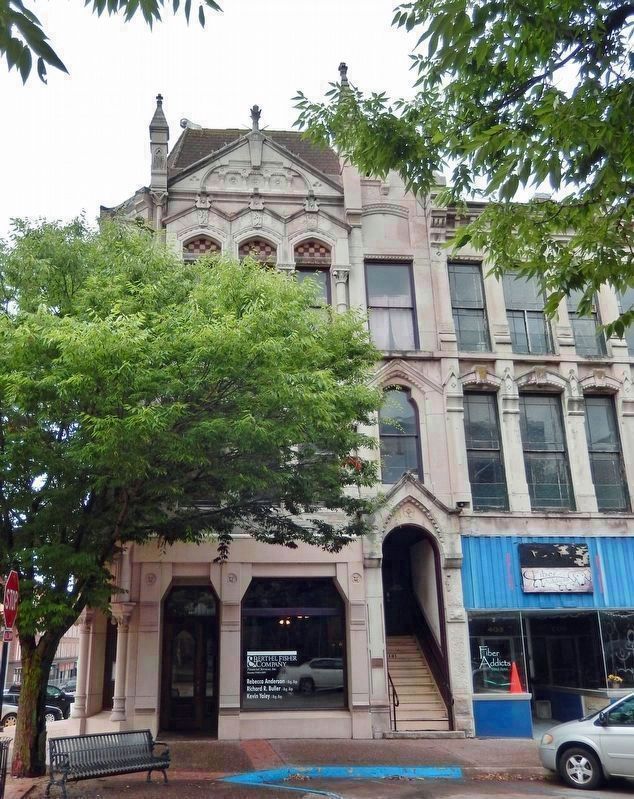Burlington in Des Moines County, Iowa — The American Midwest (Upper Plains)
Hedge's Building
1881
placed on the
National Register
of Historic Places
by the United States
Department of the Interior
Hedge's Building
1881
Topics and series. This historical marker is listed in these topic lists: Architecture • Industry & Commerce. In addition, it is included in the National Register of Historic Places series list. A significant historical year for this entry is 1881.
Location. 40° 48.607′ N, 91° 6.247′ W. Marker is in Burlington, Iowa, in Des Moines County. Marker is on Jefferson Street west of North 4th Street, on the left when traveling west. The marker is mounted at eye-level, directly on the subject building, on the left side of the front [north] entrance. Touch for map. Marker is at or near this postal address: 401 Jefferson St, Burlington IA 52601, United States of America. Touch for directions.
Other nearby markers. At least 8 other markers are within 10 miles of this marker, measured as the crow flies. 20th Anniversary of the Snake Alley Criterium (within shouting distance of this marker); The First Congregational Church (within shouting distance of this marker); First Civil War Monument West of the Mississippi (about 300 feet away, measured in a direct line); Hotel Burlington (about 500 feet away); Snake Alley (about 700 feet away); The Burlington Public Library (about 800 feet away); Engine No. 3003 / Market Square (approx. ¼ mile away); Henderson County Covered Bridge (approx. 10 miles away in Illinois). Touch for a list and map of all markers in Burlington.
Regarding Hedge's Building. National Register of Historic Places #82000405. Also a contributing Property in West Jefferson Street Historic District (NRHP #91000409) and Downtown Commercial Historic District (NRHP #14001168).
From the National Register Nomination:
Built in 1880, the Hedge Block is a particularly fine example of the Victorian Gothic commercial style. Its rich ornamentation and massive presence render it unique in downtown Burlington. Although similar in mass and height to nearby buildings, which date from the 1870s to the 1910s, the Hedge Block stands out by virtue of its corner location, variety of building materials and heavy, irregular orientation. The Hedge Block was actually a combined effort on the part of four Burlington entrepreneurs, and the plan of the structure reflects this multiple ownership and use. Thomas Hedge, Sr., E.H. Carpenter, John M. Gregg and Wesley Bonar joined together to build the Hedge Block as an investment. Each of three men owneda 20' frontage, and the fourth owned 27' on the corner. The building is generally separated in this manner with long-narrow stores on the ground floor and larger connected areas above. They hired local architect Charles A. Dunham to provide the design. Dunham was active until 1907, designing a variety of buildings in a variety of styles ranging from the Victorian Gothic to the Stick Style. Since several of his larger commissions (Warren County Courthouse, Burlington High School, Old Main at Iowa State) are not extant, the Hedge Block emerges as an even more important representative of this Iowa architect's work.Thomas Hedge, Sr., was an early and successful Burlington businessman. He started his commercial career in that city in 1843 and by 1866 was an owner of the wholesale lumber company, Gilbert, Hedge & Co. Hedge was an active promoter of the Burlington & Northwestern Railroad in the 1870s, serving as the company's first president.
Also see . . .
1. Hedge Block (Wikipedia). Excerpt:
The Hedge Block, also known as Johnson-Rasmussen Building, was constructed in 1880 in the Late Victorian Gothic Revival style. It is a three-story structure with a limestone facade on Jefferson Street, brick along Fourth Street, and a chamfered corner that joins the two elevations.(Submitted on December 29, 2023, by Cosmos Mariner of Cape Canaveral, Florida.)The Jefferson Street facade is livelier with short towers, pilasters between the widows, and Gothic arched hoods over tall, narrow windows. The Fourth Street facade is flatter, with wider windows and stone used for the keystones, hood molds, imposts, windowsills, small columns and belt courses.Photographed By Cosmos Mariner, June 25, 20213. Hedge's Building (northeast corner)From the National Register Nomination:
The local limestone used on the main facade features a chamfered one-bay corner, a three-bay gabled portion with a steeply pitched parapet and irregular towers flanking the gable, and then a smaller gabled fifth bay that marks the ground floor entrance to the second floor. Heavy piers separate windows, and heavy ornament projecting above the cornice further divides the design into units of three or four bays along Jefferson Street.
2. West Jefferson Street Historic District (Wikipedia). Excerpt:
West Jefferson Street was the main thoroughfare in the late 19th century and early 20th century through the Hawkeye Creek Valley. It led from the central business district along the Mississippi River to the Agency Road that headed westward out of town.(Submitted on December 29, 2023, by Cosmos Mariner of Cape Canaveral, Florida.)
3. Downtown Commercial Historic District (Wikipedia). Excerpt:
The downtown area developed in three periods. The first period (1865-1894) was an era of prosperity associated with the development of the city's railroad connections after the American Civil War. The second period (1895-1929) was an era of maturity and the development of modern commercial buildings. This is the time period when Burlington's "tall" downtown buildings were built. The third period (1930-1967) saw competition from suburban development, especially in West Burlington. There were efforts to retain old businesses and attract new ones, while modernizing and improving the area.(Submitted on December 29, 2023, by Cosmos Mariner of Cape Canaveral, Florida.)

Photographed By Cosmos Mariner, June 25, 2021
5. Hedge's Building / Hedge Block (northeast elevation)
From the National Register Nomination:
The brick facade along 4th Street is simpler and flatter than that of the front. Use of stone for keystones, hood molds, imposts, sills, small columns and belt courses creates a polychrome effect associated with the Victorian Gothic, especially when combined with the slate roof and terra cotta. The desired irregular outline is carried out through various window treatments, a variety of false gables, parapets and pilasters, and brick corbelling and stone dentils for the cornice. Only one of the five chimneys remain.
The brick facade along 4th Street is simpler and flatter than that of the front. Use of stone for keystones, hood molds, imposts, sills, small columns and belt courses creates a polychrome effect associated with the Victorian Gothic, especially when combined with the slate roof and terra cotta. The desired irregular outline is carried out through various window treatments, a variety of false gables, parapets and pilasters, and brick corbelling and stone dentils for the cornice. Only one of the five chimneys remain.
Credits. This page was last revised on December 29, 2023. It was originally submitted on December 29, 2023, by Cosmos Mariner of Cape Canaveral, Florida. This page has been viewed 57 times since then and 15 times this year. Photos: 1, 2, 3, 4, 5. submitted on December 29, 2023, by Cosmos Mariner of Cape Canaveral, Florida.



![Hedge's Building (<i>Jefferson Street [front] façade</i>). Click for full size. Hedge's Building (<i>Jefferson Street [front] façade</i>) image. Click for full size.](Photos7/766/Photo766671.jpg?1229202364900PM)